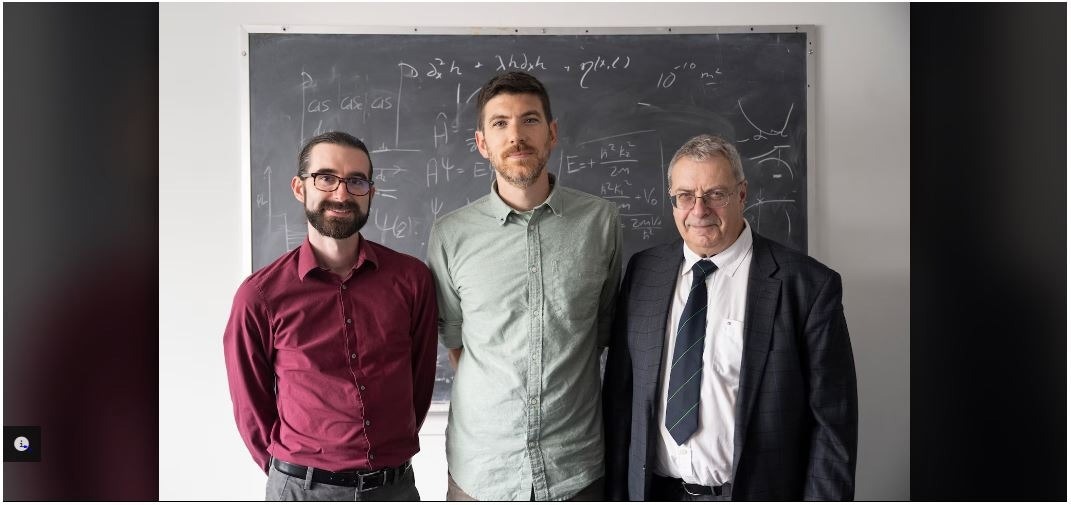Reviewed by Lexie CornerAug 1 2024
In a recent study published in the American Chemical Society (ACS) journal ACS Nano, scientists from the United States Naval Research Laboratory (NRL) confirm the discovery of a new class of semiconductor nanocrystals with bright ground-state excitons, a major breakthrough in the field of optoelectronics.
 NRL Semiconductor Nanocrystal Research Team. Michael Swift (left), Ph.D, US Naval Research Laboratory (NRL) research physicist; John Lyons (center), Ph.D, NRL physical scientist; and Alexander Efros, Ph.D, NRL senior scientist, gather for a group photo in the Materials Science and Technology facility in Washington, D.C., July 25, 2024. The team uses theory and simulation to understand, improve, and develop materials of naval importance. Image Credit: US Navy photo by Sarah Peterson
NRL Semiconductor Nanocrystal Research Team. Michael Swift (left), Ph.D, US Naval Research Laboratory (NRL) research physicist; John Lyons (center), Ph.D, NRL physical scientist; and Alexander Efros, Ph.D, NRL senior scientist, gather for a group photo in the Materials Science and Technology facility in Washington, D.C., July 25, 2024. The team uses theory and simulation to understand, improve, and develop materials of naval importance. Image Credit: US Navy photo by Sarah Peterson
The innovative theoretical research has the potential to transform the creation of high-efficiency light-emitting devices and other technologies.
The lowest-energy exciton in nanocrystals is called “dark” exciton since it usually emits light weakly. By slowing down light emission, the dark exciton restricts the functionality of devices based on nanocrystals, such as lasers and light-emitting diodes (LEDs). Scientists have long tried to solve this problem.
We set out to find new materials in which the exciton ordering is inverted so that the lowest-energy exciton is bright. Searching through open-source databases of materials using criteria informed by our theoretical modeling, we identified over 150 targets. We further narrowed this list with advanced first-principles calculations, ending up with 28 candidates for bright-exciton nanomaterials.
John Lyons, Ph.D., Theory of Advanced Functional Materials, US Naval Research Laboratory
According to more thorough modeling, at least four of these materials can produce bright ground-state excitons in nanocrystals.
Lyons added, “This discovery, made in collaboration with Prof. David Norris from Federal Institute of Technology (ETH) Zurich and Peter Sercel, Ph.D., from the Center for Hybrid Organic-Inorganic Semiconductors for Energy (CHOISE), could pave the way for the development of ultrabright and highly efficient light-emitting devices, lasers, and other technologies.”
Alexander Efros, Ph.D., senior scientist in the Materials Science division, elaborated on the implications of the research. “In our research, we have identified several bright-exciton materials that can emit light across a broad spectrum, from infrared to ultraviolet. This versatility makes them very useful for optoelectronic applications. The capability to engineer nanocrystals with bright excitonic states across this wide range opens new avenues for creating better and more efficient LEDs, solar cells, and photodetectors.”
By tackling the dark-exciton challenge, NRL scientists seek to encourage the larger nanomaterial community to focus on bright-exciton nanostructures, a field stalled for too long. Today, three of these materials are being developed at NRL as part of the Nanoscience Institute Program’s Bright Nanocrystal Emitters program, which aims to show bright-exciton behavior in the lab and apply it to future naval technologies.
Our findings demonstrate the power of combining high-throughput computational screening, pen-and-paper theory, and high-accuracy calculations of electronic structure. No one technique would be enough on its own, but together, we discovered new ultrabright nanocrystals and unlocked the power of the bright exciton across unexplored classes of materials.
Michael Swift, Ph.D., Research Physicist, US Naval Research Laboratory
The Advanced Functional Materials Theory Section conducts fundamental and practical research on electronic, biological, structural, and functional materials systems. The Section develops novel computational and theoretical techniques, modifies current approaches, and applies proven methodology to new materials and domains to pioneer new approaches to simulating materials and systems.
The Section’s objective is to comprehend, enhance, and generate materials of current and future naval value through the application of theory and simulation.
Journal Reference:
Swift, M. W., et. al. (2024) Identification of Semiconductor Nanocrystals with Bright Ground-State Excitons. ACS Nano. doi:10.1021/acsnano.4c02905